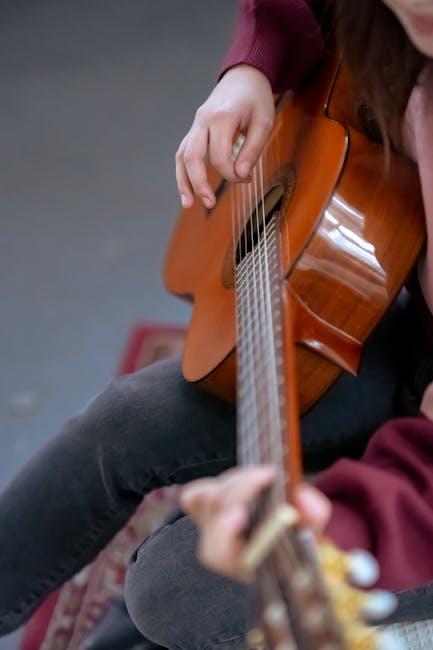Are you tired of being the guitar-by-yourself-easy-heres-why/” title=”How hard is it to learn guitar by yourself? Easy, Here's why”>G chord while everyone else gets to be the cool, complex diminished seventh? Well, fret no more my fellow guitar enthusiast because we’re about to embark on a journey to master the chords of the ultimate feel-good hit “I’m Yours” by Jason Mraz. So grab your trusty six-string and get ready to strum your way to musical bliss. Let’s make those strings sing like a bird on a sunny day!
Contents
- 1 Discovering the Magic: The Basics of “I’m Yours” Chords
- 2 Transitioning Smoothly: Techniques for Effortless Chord Changes
- 3 Adding Texture: Strumming Patterns that Elevate the Song
- 4 Finding Your Groove: Incorporating Rhythm and Tempo
- 5 The Power of Nuance: Adding Finesse with Hammer-Ons and Pull-Offs
- 6 Fine-Tuning Your Performance: Practice Tips for Mastery
- 7 Embracing the Vibe: Expressing Emotion Through Your Playing
- 8 FAQs
- 9 Rock on with Your Feel-Good Self!
Discovering the Magic: The Basics of “I’m Yours” Chords
So you’ve decided to learn how to play “I’m Yours” by Jason Mraz on the guitar. Congratulations! You’re about to delve into the magical world of playing chords that will have everyone singing along with you.
Let’s start with the basics. The chords you’ll need to know are G, D, Em, and C. Don’t worry, these are fairly common chords that you’ll find in many other songs as well. Feel free to practice switching between them until you can do it with your eyes closed (not recommended, by the way).
Once you have a good handle on those chords, you’ll want to pay attention to the strumming pattern. For “I’m Yours”, a popular strumming pattern is Down, Down-Up, Up-Down-Up. Say that five times fast while strumming, I dare you!
Now that you have the chords and strumming pattern down, it’s time to put it all together and sing your heart out. Grab your guitar, belt out those lyrics, and watch as everyone around you is mesmerized by your musical prowess. Who knows, you might even end up starting your own one-man band!

Transitioning Smoothly: Techniques for Effortless Chord Changes
Let’s face it, smoothly transitioning between chords can be a real struggle for many musicians. But fear not, dear friends, for I am here to share with you some not-so-secret techniques for effortlessly switching from one chord to another.
First and foremost, practice makes perfect. Spend some quality time with your instrument and get those fingers moving. The more you practice, the easier those chord changes will become. It’s like building muscle memory, but for your fingers.
Next, pay attention to your hand positioning. Make sure your fingers are properly placed on the fretboard and that you’re not contorting your hand into some weird, uncomfortable shape. A relaxed hand is a happy hand, and happy hands make for smooth chord changes.
Finally, don’t be afraid to cheat a little. If you’re struggling with a particular chord change, find a shortcut. Maybe you can skip a finger or play a simpler version of the chord. Remember, there are no chord change police coming to arrest you for taking the easy way out. Your goal is to make beautiful music, not impress anyone with your chord-change acrobatics.

Adding Texture: Strumming Patterns that Elevate the Song
When it comes to strumming patterns, the key is to add texture and depth to your song. Forget about the same old boring down-up-down-up routine. Let’s spice things up a bit with some unconventional strumming patterns that will take your song to the next level.
First up, let’s try the “galloping horse” strumming pattern. This pattern involves emphasizing the down strums in a triplet rhythm, creating a galloping effect reminiscent of horses racing across the prairie. It’s perfect for adding a sense of urgency or excitement to your song.
Next, why not try the “heartbeat” strumming pattern? This pattern involves alternating between quick down strums and slower up strums, mimicking the steady thump-thump of a heartbeat. It’s great for creating a sense of anticipation or building tension in your song.
And finally, let’s not forget about the “fanfare” strumming pattern. This pattern involves using a combination of quick up and down strums in a staccato rhythm, creating a bright and celebratory feel. It’s perfect for adding a sense of grandeur or exuberance to your song.

Finding Your Groove: Incorporating Rhythm and Tempo
Have you ever found yourself awkwardly swaying to the beat of a song, desperately trying to find your groove? Well, fear not, my rhythmically challenged friends, for I am here to guide you on how to incorporate rhythm and tempo into your life!
First things first, let’s talk about the importance of rhythm. Rhythm is like the heartbeat of music – it keeps everything in line and makes your body want to move. So, if you’re feeling like a wooden board on the dance floor, try tapping your foot or bobbing your head to the beat. Trust me, it works wonders!
Next up, let’s chat about tempo. Tempo is the speed at which a piece of music is played, and finding the right tempo for you is key. If you’re feeling sluggish, try picking up the pace and dancing like nobody’s watching. On the flip side, if you’re feeling overwhelmed, slow things down and sashay your way through the song.
Remember, incorporating rhythm and tempo into your life isn’t about getting it perfect – it’s about having fun and letting loose. So put on your favorite song, crank up the volume, and dance like nobody’s watching. Who knows, you might just find your groove along the way!
The Power of Nuance: Adding Finesse with Hammer-Ons and Pull-Offs
When it comes to playing the guitar, adding hammer-ons and pull-offs to your repertoire can take your skills to the next level. These techniques allow you to add finesse and nuance to your playing, creating a dynamic and engaging sound that will impress even the most discerning listeners.
With hammer-ons, you can effortlessly transition between notes by using your fretting hand to quickly hammer down on a string, producing a crisp and smooth sound. Pull-offs, on the other hand, allow you to gracefully release a note by pulling your finger off the string, creating a subtle and expressive effect.
By mastering these techniques, you can add depth and complexity to your playing, making your music more interesting and captivating. Whether you’re playing a slow ballad or a fast-paced rock solo, hammer-ons and pull-offs can help you create a rich and textured sound that will set you apart from other guitarists.
So, next time you pick up your guitar, don’t be afraid to experiment with hammer-ons and pull-offs. With a little practice and finesse, you’ll be able to add a touch of magic to your music and take your playing to new heights. Get ready to wow your audience and show off your guitar skills with style and flair!
Fine-Tuning Your Performance: Practice Tips for Mastery
So you’ve decided to take your skills to the next level and fine-tune your performance. Congratulations! Here are some practice tips that will help you achieve mastery in no time:
- Set specific goals for each practice session – whether it’s mastering a tricky passage or improving your overall technique, having a clear goal will keep you focused.
- Practice regularly - consistency is key when it comes to improvement. Even just 15 minutes a day can make a huge difference over time.
- Break your practice sessions into smaller chunks - instead of marathon practice sessions, try practicing in shorter, more focused bursts. Your brain will thank you.
Remember, it’s not just about practicing harder, but smarter. Use these tips to help you make the most of your practice time and watch your performance skills soar!
Embracing the Vibe: Expressing Emotion Through Your Playing
So, you’ve mastered the technical aspects of playing your instrument, but now it’s time to take it to the next level and really feel the music. Embracing the vibe means tapping into your emotions and letting them shine through in your playing. Here are some tips to help you express yourself on stage:
1. Let it out: Don’t be afraid to show some emotion while you play. Whether it’s joy, sadness, or anger, let it flow through your fingertips and into your music. Your audience will appreciate the rawness and authenticity of your performance.
2. Connect with the music: Close your eyes, take a deep breath, and really listen to the music. Feel the rhythm pulsing through your veins and let it guide your movements. The more connected you are to the music, the more your emotions will shine through in your playing.
3. Try different dynamics: Experiment with playing softly and then building up to a crescendo. Use your instrument to convey the highs and lows of the music, mirroring the emotional journey of the song. Don’t be afraid to take risks and push yourself out of your comfort zone.
FAQs
What are the main chords used in “I’m Yours”?
The main chords used in ”I’m Yours” are G, D, Em, C, and Dsus4. Don’t worry, they’re easier to play than they are to pronounce!
Why is it important to master these chords?
Mastering these chords will allow you to play along with the feel-good vibes of “I’m Yours” and impress all your friends at the next campfire jam session. Plus, it’s a great way to work on your chord transitions and finger strength.
Any tips for beginners struggling with chord transitions?
Practice, practice, practice! Start slow and focus on hitting each chord cleanly before moving on to the next. And remember, it’s okay to take breaks and come back to it later. Rome wasn’t built in a day, and neither is your guitar playing prowess.
What strumming pattern works best for this song?
The strumming pattern for “I’m Yours” is a simple down-up strumming pattern that repeats throughout the song. Keep it light and airy, like a gentle breeze on a sunny day.
How can I add my own flair to the song?
Feel free to experiment with different strumming patterns, fingerpicking styles, or even throwing in some fancy embellishments like hammer-ons and pull-offs. Just remember to keep it fun and true to the laid-back spirit of the song.
Rock on with Your Feel-Good Self!
Congratulations on mastering the chords of “I’m Yours”! You’re now officially one step closer to becoming a guitar virtuoso. Keep on strumming, jamming, and spreading those feel-good vibes with your newfound musical skills. And remember, if all else fails, just keep smiling and pretend like you know what you’re doing. After all, the key to success is confidence…or was it practice? Either way, keep on rocking and enjoy the musical journey ahead. Happy playing! 🎸✨



